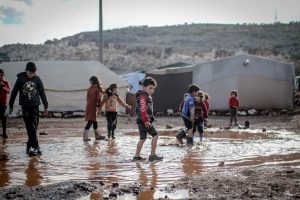
By Dr. Ryan Paul
Delivering healthcare services in refugee communities requires a specific resource deployment strategy to effectively meet the unique needs of this population. By establishing support programs and referral pathways, developing culturally appropriate resources and services, increasing access to communication technology, increasing community participation, establishing interagency coordination, employing multi-sectoral approaches, and employing data-driven strategies, healthcare providers can better address the healthcare needs of refugees. It is also important to ensure equitable distribution of resources across all refugee communities to promote fairness and equity in access to care.
Establishing support programs and referral pathways is vital in providing comprehensive care to refugees. Community-based programs should be developed in consultation with the local refugee community to offer a wide range of resources such as language classes, health and wellness services, and family support services. It is important to connect refugees with primary healthcare services and mental health services through well-defined referral pathways.
Developing culturally appropriate resources and services is crucial to providing healthcare that meets the specific needs of refugees. This involves creating programs and services that are relevant and appropriate to the refugee population, taking into consideration their cultural backgrounds and experiences. By doing so, healthcare providers can build trust and effectively address the unique healthcare challenges faced by refugees.
Increasing access to communication technology is essential in improving healthcare delivery in refugee communities. By providing internet access and mobile phones, refugees can more easily access information and services. This enables them to seek medical assistance, access educational resources, and connect with healthcare providers, thus improving their overall healthcare experience.
Increasing community participation in healthcare planning and research is crucial for addressing health disparities among refugees. By involving refugees in the development and implementation of strategies, healthcare providers can better understand the needs and preferences of this population. This participatory approach ensures that healthcare services are tailored to meet the specific needs of refugees, leading to better health outcomes.
Establishing interagency coordination is necessary for the seamless and sustainable delivery of healthcare services to refugees. Collaboration between service providers, care organizations, and local and national governments ensures that resources are effectively utilized and duplication of efforts is avoided. This coordination supports the effective provision of healthcare services and facilitates the sharing of information and resources.
Employing multi-sectoral approaches is essential in meeting the complex healthcare needs of refugees. Healthcare providers should collaborate with various government, non-profit, and private sectors to leverage their expertise and resources. By combining efforts, a holistic approach to healthcare can be achieved, addressing not only physical health but also mental health, social services, education, and employment needs.
Employing data-driven strategies helps healthcare providers identify gaps in healthcare services for refugees. By analyzing data on health outcomes, healthcare utilization, and barriers to care, providers can better understand the healthcare needs of refugees. This data can inform the planning and implementation of more effective and targeted healthcare interventions, leading to improved healthcare outcomes for refugees.
Finally, it is important to ensure the equitable distribution of resources across all refugee communities. This ensures fairness and equity in access to care, regardless of geographical location or demographic factors. By prioritizing the allocation of resources to areas of greatest need, healthcare providers can maximize the impact of their services and ensure that healthcare is accessible to all refugees.
Delivering healthcare services in refugee communities requires a specific resource deployment strategy. By considering factors such as support programs and referral pathways, culturally appropriate resources and services, access to communication technology, community participation, interagency coordination, multi-sectoral approaches, data-driven strategies, and equitable resource distribution, healthcare providers can effectively address the unique healthcare needs of this population. Implementing these strategies will contribute to improving the overall health and well-being of refugees in these communities.


buying prescription drugs in mexico
https://cmqpharma.com/# medication from mexico pharmacy
mexico pharmacies prescription drugs
mexico pharmacies prescription drugs: mexican pharmacy – mexican drugstore online
Very interesting info!Perfect just what I was searching for!Raise blog range
canadian pharmacy 365 online pharmacy canada onlinecanadianpharmacy 24
canadian online drugstore: canadian pharmacy phone number – canada discount pharmacy
mexican pharmacy: mexican mail order pharmacies – purple pharmacy mexico price list
https://canadapharmast.online/# canadian neighbor pharmacy
cheapest pharmacy canada: legitimate canadian online pharmacies – canada pharmacy online
buying from online mexican pharmacy buying from online mexican pharmacy buying from online mexican pharmacy
buy medicines online in india: buy medicines online in india – best india pharmacy
mail order pharmacy india: indianpharmacy com – best india pharmacy
indianpharmacy com buy medicines online in india cheapest online pharmacy india
https://canadapharmast.online/# pharmacy canadian
buying prescription drugs in mexico online: mexican drugstore online – п»їbest mexican online pharmacies
cheapest online pharmacy india: indian pharmacy online – online pharmacy india
Online medicine home delivery: world pharmacy india – online pharmacy india
cheap canadian pharmacy canadian drugs online canada drugstore pharmacy rx
http://indiapharmast.com/# п»їlegitimate online pharmacies india
77 canadian pharmacy: pharmacy canadian superstore – buy canadian drugs
top 10 pharmacies in india: top 10 online pharmacy in india – india pharmacy mail order
https://clomiddelivery.pro/# clomid tablet
п»їpaxlovid: paxlovid pill – п»їpaxlovid
http://doxycyclinedelivery.pro/# buy doxycycline from canada
https://ciprodelivery.pro/# ciprofloxacin 500 mg tablet price
can you get cheap clomid: where to buy cheap clomid online – can i order generic clomid without rx
http://paxloviddelivery.pro/# paxlovid for sale
http://clomiddelivery.pro/# how can i get cheap clomid no prescription
doxycycline 400 mg brand name: buy doxycycline without rx – doxycycline tablet price in india
http://doxycyclinedelivery.pro/# best price for doxycycline
can i get generic clomid: can you get clomid without insurance – order generic clomid pill
https://amoxildelivery.pro/# amoxicillin 500 mg online
http://paxloviddelivery.pro/# Paxlovid buy online
clomid rx: where to buy cheap clomid tablets – can i get cheap clomid no prescription
https://ciprodelivery.pro/# ciprofloxacin over the counter
can i order cheap clomid for sale: can you buy generic clomid pill – can you buy generic clomid without a prescription
can you get clomid without prescription: how to get clomid no prescription – can i get generic clomid without prescription